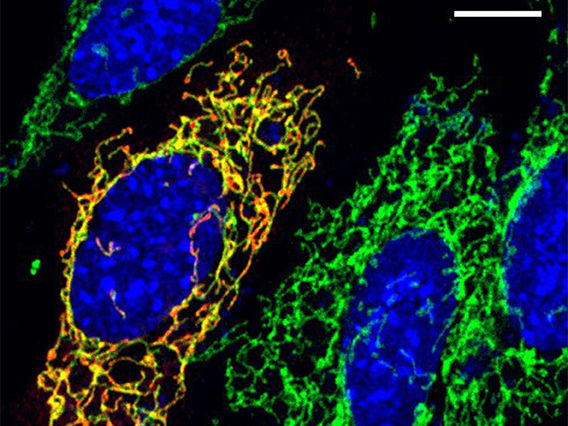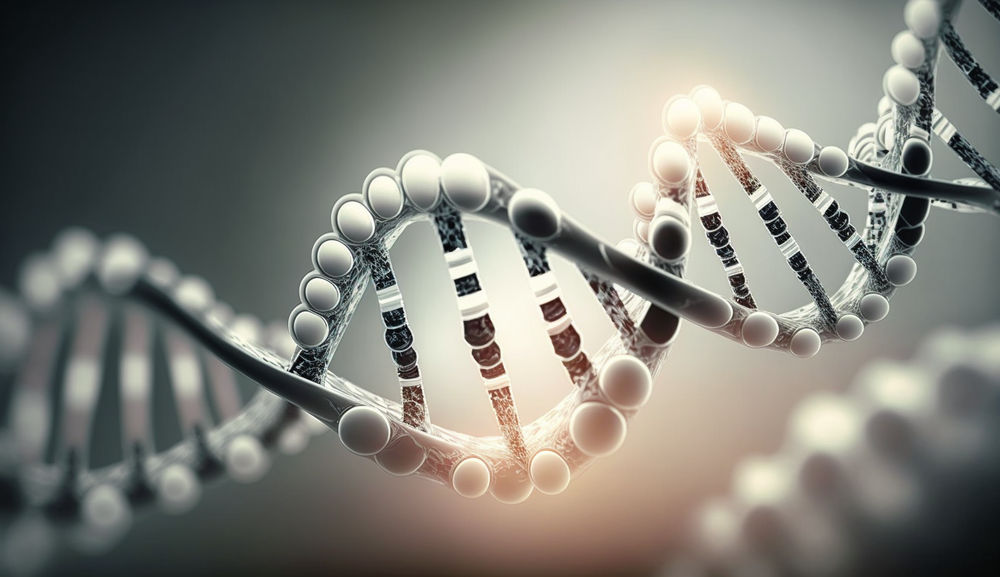Gene therapy for mitochondrial diseases
Advertisement
Mitochondrial disease is now thought to be the second most commonly diagnosed genetic disease worldwide, and, unfortunately, there are still no proven treatment strategies for those diagnosed. Scientists from the Max Planck Institute for Biology of Ageing in Cologne were involved in collaborations to apply gene-therapy approaches in mice to successfully treat an animal model of mitochondrial disease. This may pave the way for future therapeutic strategies for patients.

A virus-infected cell in a cell culture surrounded by uninfected cells. Mitochondria are shown in green. The virus shown in orange-red (left cell) is located to the mitochondria. Scale bars: 10 µm
Mitochondrial Biology Unit, University of Cambridge
Every step we take, every laugh we make, every word we say requires energy. Mitochondria play a central role in our metabolism and energy production. Consequently, mitochondrial dysfunction causes a remarkably diverse group of metabolic diseases with a broad range of symptoms leading to severe disability. “Since the 1980s it was known that mutations in the mitochondrial DNA can lead to disease” explains James Stewart, group leader at the Max Planck Institute for Biology of Ageing and continues “we have known of these patients for over 30 years and only now are we starting to develop treatments”.
A remarkable feature of mitochondria is that they contain their own DNA. Mutations in this mitochondrial DNA (mtDNA) can lead to mitochondrial diseases, but whether a person with a mutation develops disease or not is more complex. Many copies of mtDNA are present in each of our cells and, normally, disease-causing mutations are present in only a fraction of them. However, if the fraction of mutated mtDNA molecules rises above a certain threshold, mitochondrial function is compromised resulting in mitochondrial disease. Therefore, reducing the levels of mutated mtDNA molecules is a potential treatment strategy.
However, this treatment strategy is not so straightforward as conventional gene-therapy approaches do not work in mtDNA. Scientists from the University of Cambridge, UK and the University of Miami, USA, developed an approach to specifically degrade mutated mtDNA molecules in cell culture. Using a modified virus, they delivered a gene into the cell nucleus that encodes a protein that works as molecular scissors. These molecular scissors are then produced by the cell and targeted to mitochondria, where they specifically cut the mutated mtDNA.
But would the method also work in complex organisms composed of many tissues like mice or humans and actually treat mitochondrial disease? Stewart and his colleagues in Cologne could provide the answer. They had generated a mouse model of mitochondrial disease that contains a specific disease-causing mutation in mtDNA which leads to disorders in cardiac and muscular tissue. They treated the animals with the virus that only infected the heart or the muscles. The virus delivered the molecular scissor to cut the mutated mtDNA in the targeted tissue. And in fact, the approach worked! The levels of mutated mtDNA were reduced and the disease symptoms were alleviated.
“This is the first gene therapy to actually remove the cause of a mitochondrial disease in a living animal” a delighted Stewart tells us. Of course, before the therapy can be applied to human patients more detailed work and safety assessments must be done. Nevertheless, the scientists could prove that they found a way to remove the cause of these mitochondrial diseases. And since there is a link between mitochondrial dysfunction and other conditions like Alzheimer’s disease, Parkinson’s disease, diabetes, and perhaps some cancers, the approach will might even have a higher impact in fighting those disorders in the future.
Original publication
Payam A. Gammage, Carlo Viscomi, Marie-Lune Simard, Ana S. H. Costa, Edoardo Gaude, Christopher A. Powell, Lindsey Van Haute, Beverly J. McCann, Pedro Rebelo-Guiomar, Raffaele Cerutti, Lei Zhang, Edward J. Rebar, Massimo Zeviani, Christian Frezza, James B. Stewart and Michal Minczuk; "Genome editing in mitochondria corrects a pathogenic mtDNA mutation in vivo"; Nature Medicine; 2018
Sandra R. Bacman, Johanna H.K. Kauppila, Claudia V. Pereira, Nadee Nissanka, Maria Miranda, Melina Pinto, Sion L. Williams, Nils-Göran Larsson, James B. Stewart and Carlos T. Moraes; "MitoTALEN reduces mutant mtDNA load and restores tRNAAla levels in a mouse model of heteroplasmic mtDNA mutation"; Nature Medicine; 2018
Other news from the department science
Most read news
More news from our other portals
See the theme worlds for related content
Topic world Gene therapy
Genetic diseases once considered untreatable are now at the center of innovative therapeutic approaches. Research and development of gene therapies in biotech and pharma aim to directly correct or replace defective or missing genes to combat disease at the molecular level. This revolutionary approach promises not only to treat symptoms, but to eliminate the cause of the disease itself.

Topic world Gene therapy
Genetic diseases once considered untreatable are now at the center of innovative therapeutic approaches. Research and development of gene therapies in biotech and pharma aim to directly correct or replace defective or missing genes to combat disease at the molecular level. This revolutionary approach promises not only to treat symptoms, but to eliminate the cause of the disease itself.





















































